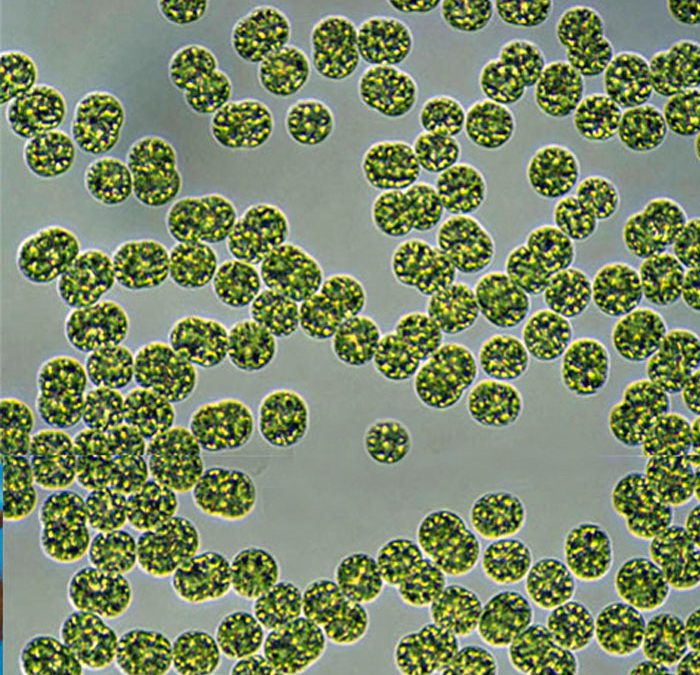
by Rick O'Connor | Oct 25, 2024
In the first article of this series, we discussed whether viruses were truly living organisms. Well, bacteria truly are. They possess all eight characteristics of life but differ from other forms of life in that they lack a true nucleus. Their genetic material just exists in the cytoplasm. This difference is large enough to place them in their own kingdom – Monera.
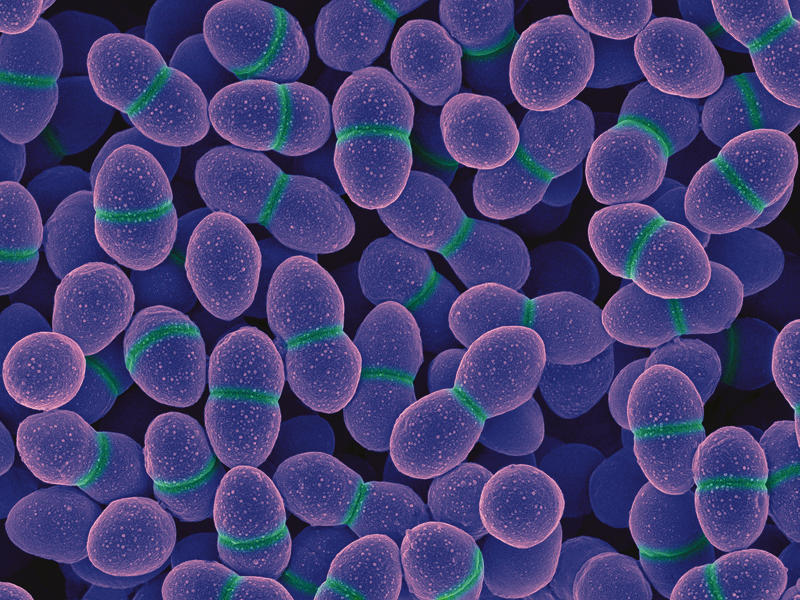
The spherical cells of the “coccus” bacteria Enterococcus.
Photo: National Institute of Health
Bacteria are single celled creatures, though some “hook” together to form long chains. A single cell will average between 5-10 microns in size. This is much larger than a virus but smaller than many eukaryotic cells (those that possess a nucleus).
To further classify bacteria microbiologists will conduct a gram-stain test. Placing a cultured sample of bacteria on a slide, you “bath” them in what is called Gram-stain. Under the microscope the bacteria that appear “pink” are called gram negative, those that appear “purple” are gram positive. Thus, all bacteria can be quickly grouped into those that are gram negative and those that are gram positive.

After staining, gram negative bacteria appear pink in color; gram positive are purple.
Image: University of Florida
The next level of classification focuses on the shape of their cells. Those that are “rod-shaped” are called bacillus and often have the term in their name – such as Lactobacillus the bacteria found in milk that makes milk smell sour as their populations grow. The “sphere-shaped” bacteria are called coccus – such as Streptococcus (the bacterium that causes strep throat) and Enterococcus (the fecal bacterium used for monitoring water quality in marine waters). And the third group are “spiral-shaped” and are called spirillum – such as Campylobacter and Helicobacter both are human pathogens.

The rod-shaped bacterium known as bacillus.
Image: Wikipedia.
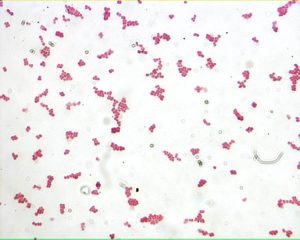
The bacterium known as coccus.
Image: Loyola University
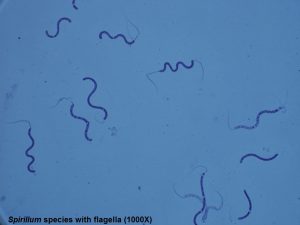
The bacterium known as spirillum.
Image: Lake Superior College.
Bacteria are very abundant in the marine and estuarine waters of the Gulf of Mexico. They can be found floating in the water column, on the surface of the sediment, beneath the surface of the sediment, and on the bodies of marine organisms. When we think of bacteria we think of “dirty” conditions and disease, but many bacteria provide very important ecological benefits to the marine ecosystem and are “good” members of the community.
One important role some bacteria play is the conversion (“fixing”) of nutrients. Animals release toxic waste when they defecate and urinate. One of these is ammonia. Ammonia can bond with oxygen depleting the body of this needed element. Nitrogen fixing bacteria can convert toxic ammonia released into the environment into nitrite. Then another group of nitrogen fixing bacteria will convert nitrite into nitrate – a needed nutrient for plants, and eventually the entire food chain.
Some bacteria are excellent decomposers. When plants and animals die we say they “decay”. What is actually happening is the decomposing bacteria are converting nutrients in their bodies to forms that are usable by living organisms. One byproduct of this decomposition process is hydrogen sulfide – which smells like rotten eggs. In biologically productive ecosystems – like swamps and marshes – the smell of hydrogen sulfide is strong – often called “swamp gas”. It is the smell of nutrient conversion and much needed. Though in high concentrations, hydrogen sulfide is toxic as well – there needs to be a balance. We see this same process happenings when we compost food waste to form fertilizers for our gardens.
One place where the smell of sulfur is very strong is near volcanic vents. If you have been to Yellowstone, or a volcano, the smell is very evident. There are what are termed “extreme bacteria” who can live in these very hot, almost toxic, environments. Just as plants take water and carbon dioxide and convert this to sugar in the process of photosynthesis, bacteria can convert toxic forms of sulfur into usable carbohydrates for other living organisms. In the 1970s marine scientists discovered thermal vents on the bottom of the ocean. These hot “chimneys” spew black clouds of smoke into the water column. Approaching these chimneys carefully they found water temperatures between 700-800°F! Living close to these chimneys they found communities of worms, shrimps, fish, and crabs. The walls of the chimneys are actually composed of sulfur fixing bacteria that are converting volcanic minerals and compounds into sugars in a process called chemosynthesis – which supports these deep-sea communities.

The black smokers – hydrothermal vents – found on the ocean floor.
Photo: Woodshole Oceanographic Institute.
Of course, there are more familiar forms of bacteria that cause disease. Called pathogens – they can be problems for all marine life and sometimes humans. Fecal bacteria associated with human waste are not toxic in themselves at low concentrations. However, if their numbers increase (due to a sewage spill, etc.) these, and other possible pathogenic human bacteria, can be a human health issue. The Florida Department of Health monitors the fecal bacteria levels weekly at beaches where humans like to swim. High concentrations will require the department to issue health advisories. We know that all sorts of bacteria begin to replicate quickly in warmer conditions. This can be a problem with seafood that is not kept cold enough before serving. There are federal regulations on what temperatures commercially harvested seafood must be kept in order to be served or sold to the public. Federal and state agencies can monitor the temperatures of stored seafood as it moves from the fishing vessel to the table. But they cannot monitor it from your fishing rod to your table – that responsibility will fall on you. Pathogenic bacteria is the primary reason we refrigerate and/or freeze much of our food.
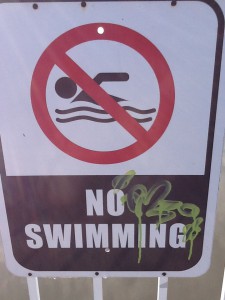
Closed due to bacteria.
Photo: Rick O’Connor
Though bacteria in general have a bad name, many species are not harmful to us and are a major player in the health of our estuarine and marine communities.
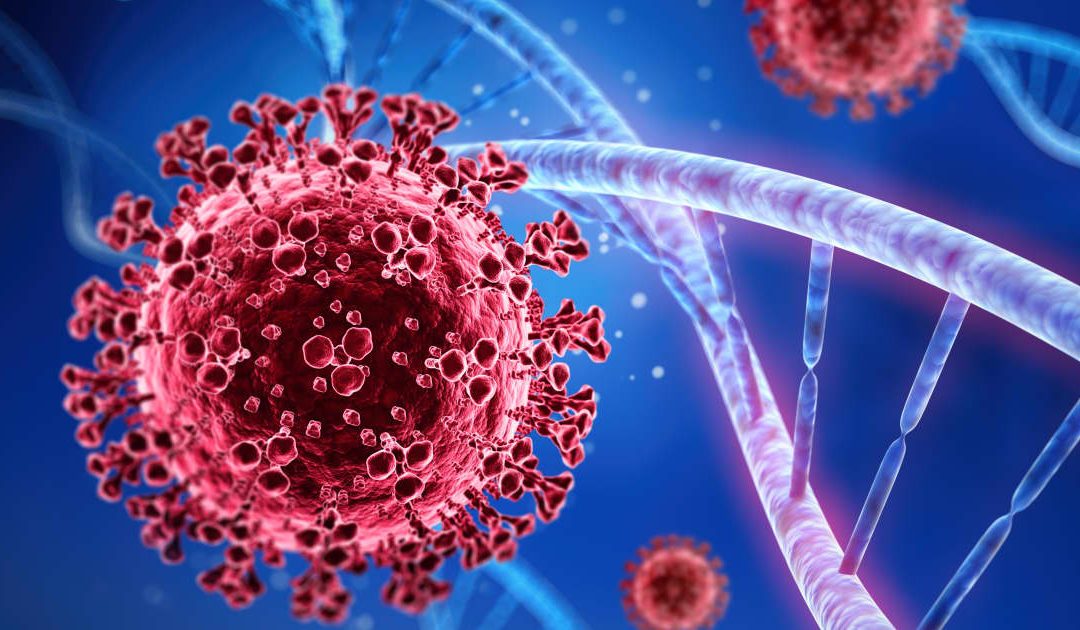
by Rick O'Connor | Oct 18, 2024
We are going to begin this series of articles with a “creature” that some do not consider alive – viruses. While studying marine science in college, and my early days as a marine science educator, there was a debate as to whether viruses were actually alive and should be included in a biology course. A quick glance at the textbooks of the time shows they were often omitted – though they were included in my microbiology class. Why were they omitted? Why did some consider them “non-living creatures”?
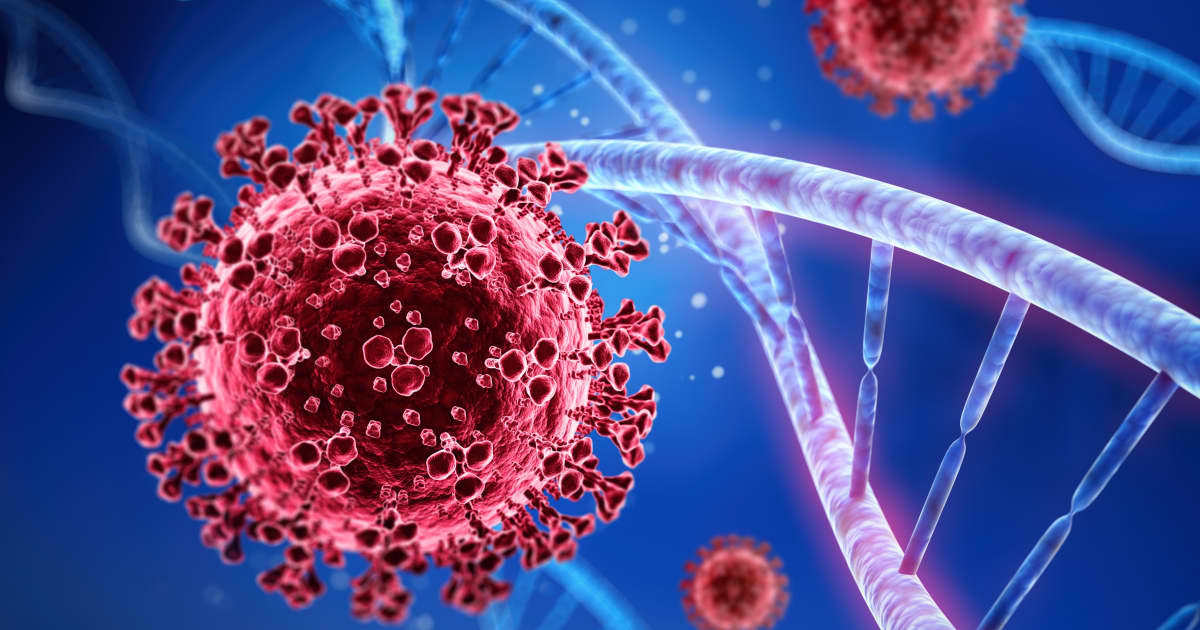
The coronavirus next to a strand of DNA.
Image: Florida International University.
Well, we always began biology 101 with the characteristics of life. Let’s scan these characteristics and see where viruses fit.
- Made of cells. This is not the case for viruses. A typical cell will include a cell membrane filled with cytoplasm and a nucleus, which is filled with genetic material (chromosomes containing DNA and RNA). An examination of a virus you will find it is either DNA or RNA encapsulated in a protein coat. It is “nucleus-like” in nature. Most cells run between 10-20 microns in size. A typical nucleus within a mammal cell will run between 5-10 microns. A typical virus would be 0.1 microns – these are tiny things – MUCH smaller than a cell.
- Process energy. Nope – they do not. Most cells utilize energy during their metabolism. Viruses do not do this.
- Growth and development. Nope again. They “spread”, which we discuss in a moment, but they do not grow. We are now 0-3.
- Homeostasis. Homeostasis is the movement of material and environmental control to remain stable – and viruses do not do this.
- Respond to stimuli. Yes… here is one they do. Studies show that viruses do respond to their chemical and physical environment.
- Metabolism. As mentioned above, this would be a no.
- Adaptation. Studies show that through very rapid reproduction they can adapt to the changing environment they are in.
- Reproduce. This is a sort of “yes/no” answer. They do reproduce (as we say – “spread”) but they do not do this on their own. They invade the nucleus within the cells of their host and replace their genetic material with that of the host creature. Then, during cell replication within the host, new viruses are produced and “spread”.
So, you can see why there is a debate. Of the eight common characteristics of life, viruses possess only three – and one of those can only be achieved with the assistance of a host creature. Now the question would be – do be labeled as a “creature” do you need ALL eight characteristics of life? Or only a few? And if only a few – how many? Because of this most biologists do not consider them alive.
During one class when we were discussing this a student made a comment – “don’t we KILL viruses? If so, then it must be alive first”. Point taken – and we should understand the phrase “kill a viruses” does not mean literally killing. It is a phrase we use. Though some argue we do kill viruses and thus…
Another point we could make here is that all life on the planet has been classified using a system developed by the Swedish botanist Carlos Linnaeus. Each creature is placed in a kingdom, then phylum, class, order, family, genus, and eventually a species name is given. We “name” the creature using its genus and species name – Homo sapiens for example. We do not see this for viruses.
All that said, both the National Oceanic and Atmospheric Administration and the National Institute of Health indicate the “most common form of life in the sea are viral-like particles” – with over 10 million in a single drop of seawater. We will leave the debate here. Your thoughts?

by Rick O'Connor | Oct 4, 2024
One of the top concerns with residents in our communities is water quality. Surveys I have conducted with the public support this statement. One of the top concerns with water quality in the coastal areas is health advisories. These are issued when concentrations of selected fecal bacteria are too high.
In coastal areas, the selected bacteria are Enterococcus. It is important to note that Enterococcus bacteria are found in the digestive systems of birds and mammals. So, its presence does not automatically mean there is human waste in the water. However, there are pathogens associated with bird and mammal waste humans should be concerned about. And very high concentrations are most likely due to human waste. Science is working on additional methods to confirm high levels of Enterococcus are human. It is assumed that these will one day be used.
Enterococcus bacteria are used in coastal waters due to their ability to tolerate higher salinity. Some species, such as E. coli, that are used in freshwater systems die in saline ones. This suggests that the waste is not there, when in fact it is. It is also important to know that Enterococcus bacteria in themselves are not health concern for us. They are in our digestive tracts. But their presence in the water indicates that waste is present and there are pathogens in this waste that are of concern – hence the advisories issued.
In this series we will look at three methods we can use to help reduce human waste from entering our local waterways. Those are (1) maintaining your septic system, (2) converting your septic system to sewer, and (3) maintaining your sewer lines. We will begin with maintaining your septic system.
Septic systems have been used in rural and suburban communities where sewer systems have not been available for decades. Even today, the growth of new neighborhoods is outpacing the sewer infrastructure to support them. Many of these new communities are using septic systems. If properly placed and maintained, septic systems can work well. But many are not placed in good locations, and most are not maintained.
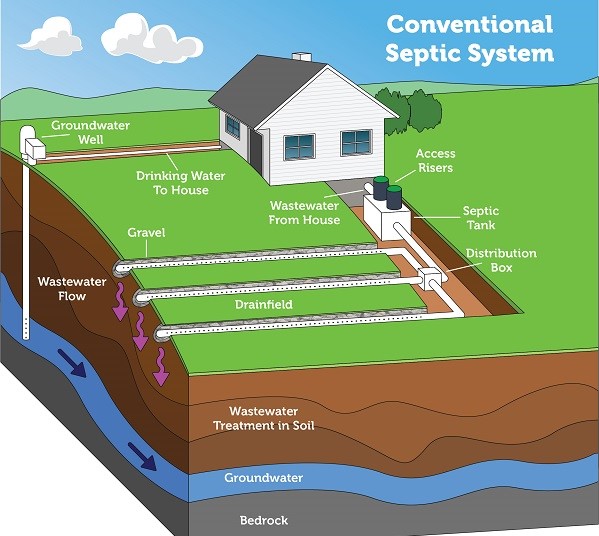
A conventional septic system is composed of a septic tank and a drainfield, where most of the wastewater treatment takes place. Image: US EPA
The system begins with the water leaving your home and entering a large tank made of concrete, fiberglass, or polyethylene buried in the yard. The average size of these tanks is 1000 gallons, but – depending on the number of bedrooms and bathrooms in the house, they could be larger. Here the sewage sits. Over time the solid waste will settle on the bottom (sludge) while the fats, oils, and grease float to the surface. The liquid layer in the middle (effluent) will flow from the tank into a series of smaller perforated drainpipes that slowly discharge into a drain field. A properly designed drain field will have a layer of sand that will allow draining of the effluent to occur.
Let’s talk about how to maintain this system.
- Do not overload the system with too much water. The tank is designed for a specific number of bedrooms/bathrooms. Overusing water can fill the tank and initiate leaking before the sewage has had time to settle. Watch your water use.
- Watch what you are flushing down the drain. Fats, oils, grease, and even milk will solidify and clog the lines. There are many products that describe themselves as “flushable”. They are, but they are not biodegradable. These two will cause clogs and backups in the system. Some harsh cleaning products can harm the bacteria within the tank who are breaking down the waste – these should be avoided. Also avoid using the garbage disposal. Septic systems were designed for water and sewage, not garbage and food. Compost your food waste instead.
- Periodically have your tank pumped and inspected. This is a step that many do not follow and can lead to leaking of untreated sewage into local waterways. It is recommended that you have your septic tank pumped and inspected once every 3-5 years. There are several businesses in your area who do this type of work. They can also provide advice on how to better maintain your specific system.
- Protect your drain field. Do not drive over this area of your lawn. Vehicles can compact the porous soil needed for efficient percolation and possible crack pipes. Planting trees and shrubs in this area can introduce roots into the lines, plant shallow root plants only. Design your landscape so that rainwater does not flow over the drain field during storms. The draining of your system is designed to be a slow process, allowing both physical and biological treatment of the waste to occur before reaching any water source. Rain and flooding conditions impede this from happening.
Developing a septic maintenance plan for your property can help reduce the number of health advisories your community will see. For more information contact your county health department or extension office.
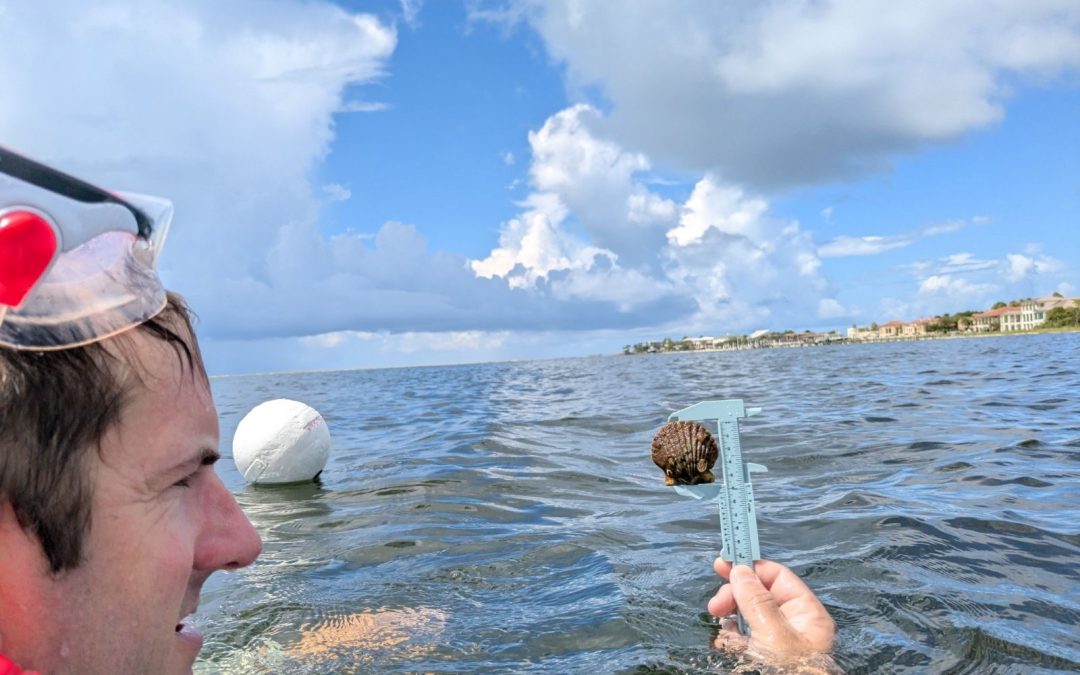
by Rick O'Connor | Aug 30, 2024
Introduction
The bay scallop (Argopecten irradians) was once common in the lower portions of the Pensacola Bay system. However, by 1970 they were all but gone. Closely associated with seagrass, especially turtle grass (Thalassia testudinum), some suggested the decline was connected to the decline of seagrass beds in this part of the bay. Decline in water quality and overharvesting by humans may have also been a contributor. It was most likely a combination of these factors.
Scalloping is a popular activity in our state. It can be done with a simple mask and snorkel, in relatively shallow water, and is very family friendly. The decline witnessed in the lower Pensacola Bay system was witnessed in other estuaries along Florida’s Gulf coast as well. Today commercial harvest is banned, and recreational harvest is restricted to specific months and to the Big Bend region of the state. With the improvements in water quality and natural seagrass restoration, it is hoped that the bay scallop may return to lower Pensacola Bay.
Since 2015 Florida Sea Grant has held the annual Pensacola Bay Scallop Search. Trained volunteers survey pre-determined grids within Big Lagoon and Santa Rosa Sound. Below is the report for both the 2024 survey and the overall results since 2015.
Methods
Scallop searchers are volunteers trained by Florida Sea Grant. Teams are made up of at least three members. Two snorkel while one is the data recorder. More than three can be on a team. Some pre-determined grids require a boat to access, others can be reached by paddle craft or on foot.
Once on site the volunteers extend a 50-meter transect line that is weighted on each end. Also attached is a white buoy to mark the end of the line. The two snorkelers survey the length of the transect, one on each side, using a 1-meter PVC pipe to determine where the area of the transect ends. This transect thus covers 100m2. The surveyors record the number of live scallops they find within this area, measure the height of the first five found in millimeters using a small caliper, which species of seagrass are within the transect, the percent coverage of the seagrass, whether macroalgae are present or not, and any other notes of interest – such as the presence of scallop shells or scallop predators (such as conchs and blue crabs). Three more transects are conducted within the grid before returning.
The Pensacola Scallop Search occurs during the month of July.
2024 Results
A record 168 volunteers surveyed 15 of the 66 1-nautical mile grids (23%) between Big Lagoon State Park and Navarre Beach. 152 transects (15,200m2) were surveyed logging 133 scallops. An additional 50 scallops were found outside the official transect for a total of 183 scallops for 2024.
2024 Big Lagoon Results
75 volunteers surveyed 7 of the 11 grids (64%) within the Big Lagoon. 67 transects were conducted covering 6,700m2.

101 scallops were logged with an additional 42 found outside the official transects. This equates to 3.02 scallops/200m2. Scallop searchers reported blue crabs and conchs, both scallop predators, as well as some sea urchins. All three species of seagrass were found (Thalassia, Halodule, and Syringodium). Seagrass densities ranged from 5-100%. Macroalgae was present in six of the seven grids (86%) but was never abundant.
2024 Santa Rosa Sound Results
93 volunteers surveyed 8 of the 55 grids (14%) in Santa Rosa Sound. 85 transects were conducted covering 8,500m2.

32 scallops were logged with an additional 8 found outside the official transects. This equates to 0.76 scallops/200m2. Scallop searchers reported blue crabs, conchs, and sand dollars. All three species of seagrass were found. Seagrass densities ranged from 50-100%. Macroalgae was present in five of the eight grids (62%) and was abundant in grids surveyed on the eastern end of the survey area.
2015 – 2024 Big Lagoon Results
| Year |
No. of Transects |
No. of Scallops |
Scallops/200m2 |
| 2015 |
33 |
0 |
0.00 |
| 2016 |
47 |
0 |
0.00 |
| 2017 |
16 |
0 |
0.00 |
| 2018 |
28 |
0 |
0.00 |
| 2019 |
17 |
0 |
0.00 |
| 2020 |
16 |
1 |
0.12 |
| 2021 |
18 |
0 |
0.00 |
| 2022 |
38 |
0 |
0.00 |
| 2023 |
43 |
2 |
0.09 |
| 2024 |
67 |
101 |
3.02 |
| Big Lagoon Overall |
323 |
104 |
0.64 |
2015 – 2024 Santa Rosa Sound Results
| Year |
No. of Transects |
No. of Scallops |
Scallops/200m2 |
| 2015 |
01 |
0 |
0.00 |
| 2016 |
01 |
0 |
0.00 |
| 2017 |
01 |
0 |
0.00 |
| 2018 |
01 |
0 |
0.00 |
| 2019 |
01 |
0 |
0.00 |
| 2020 |
01 |
0 |
0.00 |
| 2021 |
20 |
0 |
0.00 |
| 2022 |
40 |
2 |
0.11 |
| 2023 |
28 |
2 |
0.14 |
| 2024 |
85 |
32 |
0.76 |
| Santa Rosa Sound Overall |
1731 |
36 |
0.42 |
1 Transects were conducted during these years but data for Santa Rosa Sound was logged by an intern with the Santa Rosa County Extension Office and is currently unavailable.
Discussion
Based on a Florida Fish and Wildlife Research Institute publication in 2018, the final criteria are used to classify scallop populations in Florida.
| Scallop Population / 200m2 |
Classification |
| 0-2 |
Collapsed |
| 2-20 |
Vulnerable |
| 20-200 |
Stable |
Based on this, over the last nine years we have surveyed, the populations in lower Pensacola Bay are still collapsed. However, you will notice that in 2024 the population in Big Lagoon moved from collapsed to vulnerable for this year alone.
There are some possible explanations for this.
- The survey effort in Big Lagoon was stronger than Santa Rosa Sound. 75 volunteers surveyed 7 of the 11 grids. This equates to 11 volunteers / grid surveyed and 64% of the survey area was covered. With Santa Rosa Sound there were 93 volunteers who surveyed 8 of the 55 grids. This equates to 12 volunteers / grid surveyed but only 14% of the survey area was covered. Most of the SRS grids surveyed were in the Gulf Breeze/Pensacola Beach area. More effort east of Big Sabine may yield more scallops found.
- There is the possibility of different teams counting the same scallops. Each grid is 1-nautical mile, so the probability of one team laying their transect over an area another team did is low, but not zero.
- It is known that scallops have periodic population booms. Our search this year may have witnessed this. We will know if encounters significantly decrease in 2025.
Whether there was double counting this year or not, the frequency of encounter was much higher than in previous years. There were multiple reports from the public on social media about scallop encounters as well, and in some places we did not survey. It is also understood that scallops mass spawn. So, high density populations are required for reproductive success. The “boom” we witnessed this year suggests that there is a population of scallops – albeit a collapsed one – in our bay. It is important for locals NOT to harvest scallops from either body of water. First, it is illegal. Second, any chance of recovering this lost population will be lost if the adult population densities are not high enough for reproductive success.
Acknowledgements
We would like to thank ALL 168 volunteers who surveyed this year. We obviously could not have done this without you.
Below are the “team captains”.
Harbor Amiss Glen Grant Eric Stone
David Anderson Phil Harter Neil Tucker
Laura Baker Gina Hertz Christian Wagley
Melinda Bennett Sean Hickey Jaden Wielhouwer
Samantha Bergeron (USM class) John Imhof Keith Wilkins
Cheri Bone Jason Mellos Christy Woodring
Cindi Cagle Greg Patterson
Cher Clary Kelly Rysula

A team of scallop searchers celebrates after finding a few scallops in Pensacola Bay.

Volunteer measures a scallop he found. Photo: Abby Nonnenmacher
Rick O’Connor Florida Sea Grant; Escambia County
Thomas Derbes II Florida Sea Grant; Santa Rosa County
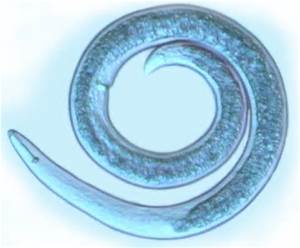
by Rick O'Connor | Aug 23, 2024
Roundworms differ from flatworms in that… well… they are round. You might recall from Part 1 of this series that flatworms were flat which helps with exchange of materials inside and out of the body. Flatworms were acoelomates – they lack an interior body cavity and thus lack internal organs. So, gas exchange (etc.) must occur through the skin. And a flat body increases the surface area in order to do this more efficiently.
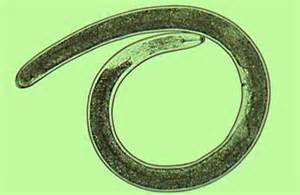
A common nematode.
Photo: University of Florida
But roundworms are round, which reduces this surface area and reduces the efficiency of material exchange through the skin. Though gas exchange through the skin does happen, it is not as efficient. So, there is the need for internal organs and that means there is a need for an internal body cavity to hold these organs. But with the roundworms there is only a partial cavity, not a complete one, and the term pseudocoelomate is used for them. Though the round body has adaptations to deal with gas exchange, it is a better shape for burrowing in the soil and sediment.
There are about 25,000 described species of roundworms, though some estimate there may be at least 500,000. They are placed in the Phylum Nematoda and are often called nematodes. Nematodes live within the interstitial spaces of soil, sediment, and benthic plant communities. They have been found in the polar regions, the tropics, the bottom of the sea, and in deserts – they are everywhere. They are usually in high numbers. One square meter of mud from a beach in Holland had over 4,000,000 nematodes. Scientists have estimated that an acre of farmland may have at least 1 billion of them. A decomposing apple on the ground in an orchard had about 90,000 nematodes. So, they are found everywhere and usually in great abundance. There are parasitic forms as well and they attack almost all groups of plants and animals. Food crops, livestock, and humans have made this group of nematodes a concern in our society.
Like many pseudocoelomates, nematodes have an anterior end with a mouth, but no distinct head – rather two tapered ends. Most of the free-living nematodes are less than 3mm (0.1in), but some soil nematodes can reach lengths of 7mm (0.3in) and there are marine nematodes that can reach 5cm (2in.) – it is a group of small worms.
Roundworms usually need water in order to move, even the soil species. They typically wriggle and undulate, similar to a snake, when moving and under a microscope they wriggle quite fast. In aquatic habitats they may swim for a short distance, and a few terrestrial species can crawl through dry sand.
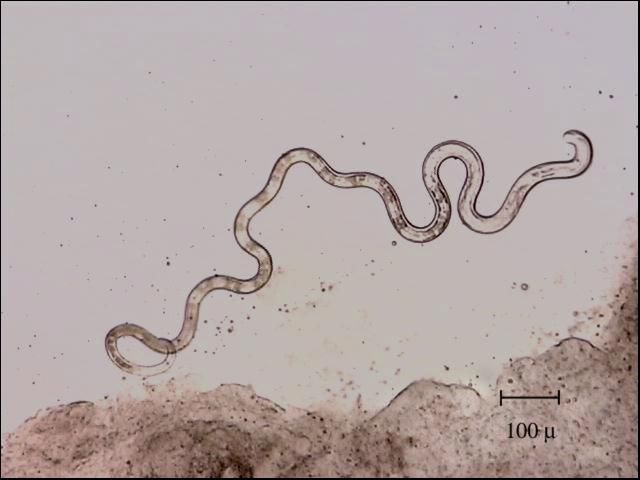
Marine Nematode – Dr. Roy P. E. Yanong, UF/IFAS Tropical Aquaculture Lab
Many free-living nematodes are carnivorous and feed on tiny animals and other nematodes. Some feed on microscopic algae and fungi. Some terrestrial species pierce the roots of plants and digest the material within. Many marine species will feed on detritus lying on the seafloor. The carnivorous species may possess small teeth, and many have a stylet they can use to pierce prey or the plant root to access food. The mouth leads to a long digestive tract and eventually an anus – nematodes have a complete digestive tract.
The brain is basically a nerve ring near the head that leads to numerous nerve chords that run the length of the body. Sensory cells are most associated with the sense of touch and smell.
Having separate sexes is the rule for nematodes, but not for all. Males are usually much smaller and usually have a hooked posterior end which they use to hold the female during mating. 50-100 eggs are usually produced and laid within the environment.
Farmers and horticulturists are familiar with these free-living nematodes, but it is the parasitic ones that are most known to the general public. There are many different forms of parasitism within nematodes. Dr. L.H. Hyman categorized them as follows:
- Ectoparasites that feed on the external cells of plants – using their stylet to pierce the plant tissue and remove nutrients.
- Endoparasites of plants. Juveniles of some nematodes enter plants and feed on tissue. This can cause tissue death and gall-like structures.
- Some free-living nematodes, while juveniles, will enter the bodies of invertebrates and feed on the tissue when the invertebrate dies.
- Endoparasites within invertebrates as juveniles, but the adult stage is free-living.
- Some are plant parasites as juveniles and animal parasites as adults. The females live within the bodies of plant eating insects, where they give birth to their young. When the insects pierce the plant tissue, the juveniles enter the plant and begin feeding on it. When they mature into adults, they re-enter the insects and the cycle begins again.
- Those that live within animals. The eggs, or newly hatched young, may be free-living for a short period, where they find new animal hosts, but the majority of the life cycle occurs within the animal. Many known to us infect dogs, cats, pigs, cattle, horses, chickens, fish, and humans.
Heartworms, pinworms, and hook worms are names you may have heard. For dog nematodes, the eggs are released into the environment by the dog’s feces. Another dog eats this feces and becomes infected.
The nematode known as Ascaris lumbricoides is the most common parasitic worm in humans. It has been estimated that almost 1 billion people are infected with it. Female Ascaris release developing eggs into the environment via human feces. Other humans become infected after swallowing food or water containing the eggs. Once inside the human, the eggs hatch and penetrate the tissue moving into the heart and eventually the lungs. From here they crawl up the trachea inducing a coughing response which is followed by a swallowing response that moves the developing juvenile worm into the esophagus and eventually back to the intestines where the cycle begins again. Infections of this worm are more common where sanitation systems are not adequate and/or human feces are used as a fertilizer.
Hookworms are another human parasite that feed on blood and can cause serious infections in humans due to blood and tissue loss. Fertilized eggs of this worm are laid in the environment and re-enter new human host as developing juveniles by penetrating their skin. Once in the new host the developing worms are carried to the lungs via the circulatory system and work their way into the pharynx, are swallowed, and eventually end up in the intestine. Not all hookworm juveniles penetrate through the skin but rather enter the body when the person unknowingly consumes human feces. This can happen from not washing your hands or food (if human waste is used as fertilizer). Pinworms and whipworms are other nematodes that have similar life cycles. In Asia there are some nematodes that are passed to humans by biting insects.
The roundworm known as the nematode is a common issue for farmers, horticulturists, and as a parasite in some parts of the world. Their lifestyles, while being a potential problem for us, have been very successful for them. In the next edition in this series, we will learn more about the most advanced worms on our planet – the segmented worms. We will begin with the polychaetes.
References
Barnes, R.D. (1980). Invertebrate Zoology. Saunders Publishing. Philadelphia PA. pp. 1089.
Ascaris lumbricoides. 2024. Wikipedia. https://en.wikipedia.org/wiki/Ascaris_lumbricoides.




















